
Recently, Bitcoin has fluctuated and fell from a high level, coupled with the concentrated selling of ancient giant whales, market panic continues to ferment.At the same time, MicroStrategy (MSTR), which is regarded as Bitcoin’s “US leverage”, has continued to fall since July 15, with a cumulative decline of more than 20% in 12 trading days, and its put options trading volume has increased by 300% month-on-month.This further aggravates the pessimism in the market.Market Chameleon data shows BitcoinThe difference in the implicit volatility between one-year put options and call options turned from negative to positive on July 24 and reached 4.8% on August 1, a new high since April 9.The change suggests that traders are stepping up bets on further declines in MSTR stock prices.So, will the further decline of MSTR drag down Bitcoin?

Although MSTR has always been highly correlated with Bitcoin price trends, this round of decline reflects more the early release of its financial risks: As the financing window for low-interest convertible bonds closed, the company turned to a more aggressive capital structure—financing tools gradually upgraded from common stocks and preferred stocks to high-cost floating-rate perpetual preferred stocks.This shift not only significantly boosted the credit risk premium, but also significantly increased the pressure on annual dividend expenditure.
According to the preferred stock terms issued by MSTR, its annual dividend expenditure will reach US$587.7 million, which will include: STRK (US$45.04 million), STRF (US$210 million), STRD (US$110 million) and STR-C (US$222.66 million).According to the financing plan disclosed on August 1, if MSTR completes the issuance of US$4.2 billion in preferred stock (face interest rate 9%), annual dividend expenditure will surge to $965.7 million, a 64% increase from current levels.As MSTR cash flow is highly dependent on financing, companies may face default risks or be forced to sell off their Bitcoin reserves once external funding is blocked – which also explains why the implicit volatility of one-year put options has soared recently.
However, considering that MSTR’s asset premium rate is still nearly 35%, the short-term bubble squeeze effect has little impact on Bitcoin (unless the asset premium rate turns negative).
In the previous article, the author pointed out that there is a short-term adjustment demand for Bitcoin, mainly because it has a too rapid rise in the process of breaking through the historical high, resulting in a fault in the chip distribution.According to glassnode data, after exceeding $120,000, the proportion of Bitcoin holders who have not achieved profitability has exceeded two standard deviations (2SD), that is, more than 95% of holders are in a profitable state.It is worth noting that since November 2021, whenever Bitcoin investors have not achieved profits exceeding two standard deviations, the probability of oscillating adjustments in the next two months has reached 100%.
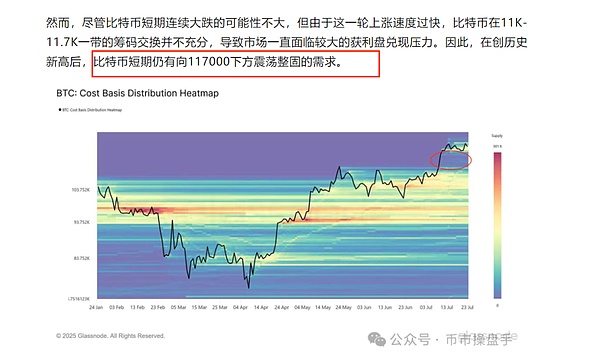
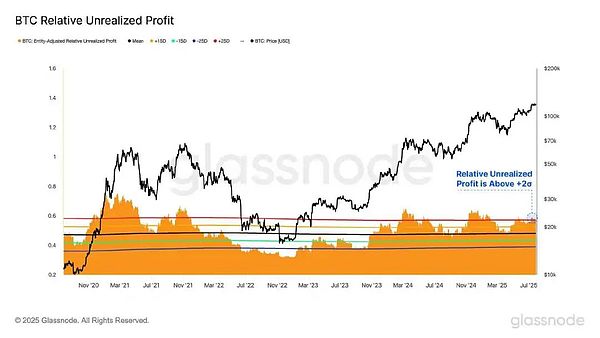
Recently, after adjustments over the past two weeks, Bitcoin has started to exchange chips in the range of $117,000-110,000.The market’s average 30-day holding cost has gradually increased from US$112,000 to US$114,500, and the proportion of holders who have not realized profits has also fallen from 95.3% to below 90% (currently 89.7%).Referring to the proportion of investors who did not realize profits in the previous two rounds of adjustments, the proportion of investors who returned to the average.Even though there is not much room for Bitcoin to adjust downward (the previous round of adjustment was 11.2%, and this round of adjustment is likely to be less than 11.2%, but 8% have been completed at present), the current sideways fluctuation is still obviously insufficient.
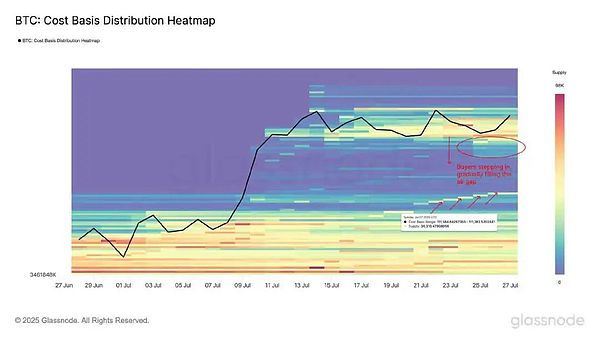
On August 2, the Chairman of the Securities and Exchange Commission (SEC) officially launched the “Project Crypto” regulatory innovation program. The strategy introduced three core measures for the first time – relaxing asset issuance access standards, establishing a technological innovation exemption mechanism, and cultivating super applications with economies of scale, aiming to systematically enhance the United States’ leadership in the global crypto assets field.As the plan focuses on asset tokenization (especially RWA) and application innovation (especially DeFi direction), Ethereum has once again received strong policy support after the GENIUS Act.
The reason why Ethereum is close to the water is the first thing to do is to get the moon.Due to its systematic advantages in the crypto-economic ecosystem, it is mainly reflected in the following three aspects: First, Ethereum carries 53% of the total stablecoin value of the entire market and processes 45% of the average daily transaction volume of stablecoins; second, in the field of decentralized finance, the locked value of the Ethereum protocol accounts for as much as 65%, while supporting nearly 80% of the tokenized US Treasury market; most importantly, leading trading platforms such as Coinbase, Kraken, Robinhood, and institutional-level participants such as Sony regard Ethereum as the preferred infrastructure network for their blockchain business.
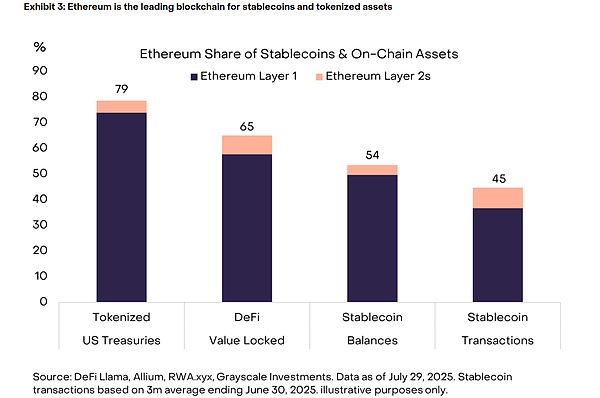
With the dual policies of the GENIUS Act and “Project Crypto”, Ethereum is transforming from a public chain platform to a core hub connecting traditional finance and crypto economy, and its “institutional-level” network effect has formed an insurmountable competitive barrier.These policy dividends not only consolidate Ethereum’s market leadership, but also indicate that the crypto industry will usher in a new wave of institutional development.
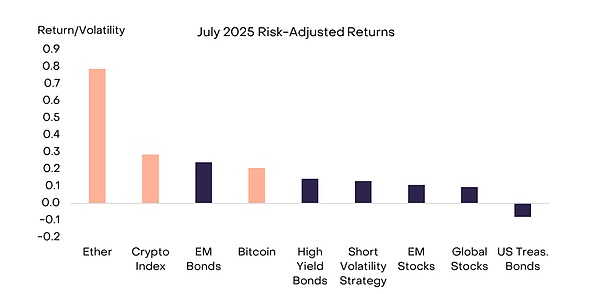
The cryptocurrency market showed significant differentiation in July: the FTSE/Grayscale Cryptocurrency Industry Market Index (the market value weighted index tracking investable digital assets) rose by 15% in total, among which Ethereum performed the most, with a surge of 49% in a single month, significantly outperforming Bitcoin’s 8% increase and other categories of digital assets.This tableThe driving force of Ming market is undergoing a major change.Under the stock pattern, funds will always flow in the direction of least resistance.When the trend is already obvious, ordinary people just need to follow!







